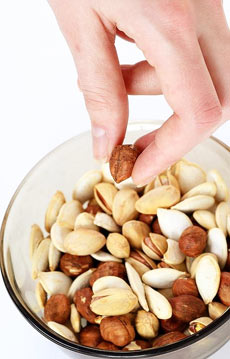|
|
Manganese: Instrumental in Insulin Production
 A
study was conducted in Madrid (Spain) to understand the relationship between
an adequate manganese (Mn) intake and
glucose, insulin levels and insulin resistance among healthy children. The
results showed that girls with an inadequate intake (below the 100% of the
recommended value) had higher insulin and HOMA values than girls with adequate
AI values (equal or higher to 100% of that recommended). Keeping in mind the
confounding factors (energy, carbohydrates and lipids intake,
BMI and age),
a significant positive correlation was found between the contribution of Mn
intake to AI and HOMA levels in girls. Thus, it seems important to ensure an
adequate Mn intake in girls in order to prevent insulin resistance and
diabetes A
study was conducted in Madrid (Spain) to understand the relationship between
an adequate manganese (Mn) intake and
glucose, insulin levels and insulin resistance among healthy children. The
results showed that girls with an inadequate intake (below the 100% of the
recommended value) had higher insulin and HOMA values than girls with adequate
AI values (equal or higher to 100% of that recommended). Keeping in mind the
confounding factors (energy, carbohydrates and lipids intake,
BMI and age),
a significant positive correlation was found between the contribution of Mn
intake to AI and HOMA levels in girls. Thus, it seems important to ensure an
adequate Mn intake in girls in order to prevent insulin resistance and
diabetes
In another instance, Manganese supplementation was tried because of the
ineffectiveness of high doses of insulin in maintaining normal blood glucose and
the patient's statement that his diabetic condition could be controlled to some
extent by an extract of lucerne (alfalfa, Medicago sativa). Analysis of the
alfalfa extract revealed a high concentration of manganese In contrast to the
effectiveness of manganese, oral supplements of zinc, magnesium, cobalt or iron
had no effect on the patient's blood sugar levels, indicating a specific role
for manganese in insulin release or action.
Recommended Daily Requirements of Magnesium:
- Children
- 1-3 years old: 80 milligrams
- 4-8 years old: 130 milligrams
- 9-13 years old: 240 milligrams
- 14-18 years old (girls): 360 milligrams
- Adult females: 310 milligrams
- Pregnancy: 360-400 milligrams
- Breastfeeding women: 320-360 milligrams
|
According to recent USDA surveys, the average intake of magnesium by
women 19 to 50 years of age was about 74 percent of the RDA. About 50 percent of
women had intakes below 70 percent of their RDA.
The question that arises is, what are the nutritional sources of Manganese?
Food Sources of Manganese
Some of the best sources of dietary manganese include grains, rice, soy beans, eggs, nuts, olive oil, green beans, oysters and tea.
-
Leafy Greens: Green vegetables such as spinach are good sources
of magnesium because the center of the chlorophyll molecule (which gives
green vegetables their color) contains magnesium. One cup of swiss chard,
cooked, provides 150.5 mg and 1 cup of spinach, cooked, provides 156.6 mg;
meeting 19.4 and 17 percent of the DV, respectively.
-
Legumes: Soybeans and peanuts are magnesium-rich legumes. A
1/2-cup serving of mature soybeans, cooked, provides 75 mg or 20 percent of
the DV and 1 oz. of dry-roasted peanuts offers slightly less, about 65 mg or
15 percent of the DV, according to the NIH Office of Dietary Supplements.
Great as a snack or as an addition to salads, roasted soybeans (known as
Edamame) are also a great source of manganese. Edamame provides 2.2mg (108%
DV) of manganese per 100 gram serving, or 3.7mg (186% DV) per cup.
-
Spices &
Herbs:
Ground cloves provide the most manganese with 60.27mg per 100 gram
serving. Saffron provides half as much with 28.41mg (14% DV) per 100 grams,
and is followed by
cardamom, ground ginger, cinnamon, dry spearmint,
parsley, bay leaf, tarragon, turmeric, dry coriander, and finally dried
marjoram which provides 0.05mg (3% DV) per teaspoon.
-
 Nuts:
A 1-oz. portion of dry-roasted almonds or cashews provide 80 and 75 mg of
magnesium, respectively, meeting approximately 20 percent of the recommended
daily value or DV. Hazel nuts provide 12.65mg per 100 grams. Pine
nuts
provide 2.5mg (123% DV) per ounce (~167 kernels), and pecans provide 1.3mg
(63% DV) of manganese per ounce (~19 pieces). Nuts:
A 1-oz. portion of dry-roasted almonds or cashews provide 80 and 75 mg of
magnesium, respectively, meeting approximately 20 percent of the recommended
daily value or DV. Hazel nuts provide 12.65mg per 100 grams. Pine
nuts
provide 2.5mg (123% DV) per ounce (~167 kernels), and pecans provide 1.3mg
(63% DV) of manganese per ounce (~19 pieces).
-
Wheat Germ & Bran: Whole grains are another excellent source of
this important nutrient. Whole grain oats, cooked, offers 4.9 mg per 100
grams. Cooked buckwheat provides 86.7 mg of magnesium or 21.4 percent of the
DV per cup, according to the World's Healthiest Foods website. Toasted wheat
germ (not bran) contains the most manganese with 20mg (998% DV) per 100 gram
serving, which is 22.6mg (1128% DV) per cup, and 1.41mg (70% DV) per
tablespoon.
Wheat
bran provides 6.7mg (334% DV) per cup, rice bran provides 16.8mg (838%
DV) per cup, and oat bran provides 2.1mg (106% DV) of manganese per cup.
-
Dark Chocolate: Yippee! but watch the sugar. Most dark chocolates
contain between thirty-five and fifty percent cocoa products, a ratio
favored by gourmet bakers. Unsweetened baking
chocolatee provides 4.16 per 100 grams of manganese.
Click here, for more.
-
Seeds:
Flax and Sesame seeds are a great source of heart healthy oils and also
provide a good source of manganese. Sesame Butter (Tahini) provides 2.54mg
(211% DV) per 100 gram serving, or 0.41mg (20% DV) per tablespoon. Dried
sesame
seeds and flax seeds provide 2.5mg (123% DV) per 100 gram serving, or
0.25mg (12% DV) per tablespoon. Pumpkin and squash seeds contain 0.5mg (25%
DV) of manganese per 100g serving, 0.32mg (16% DV) per cup, and 0.14mg (10%
DV) per ounce (85 seeds). Sunflower seeds provide 2.11mg (106% DV) of
manganese per 100 gram serving, that is 2.7mg (135% DV) per cup hulled, and
0.59mg (30% DV) per ounce.
You can use a magnesium rich salt such as Solo. Use a bottled water rich in
magnesium. Hard water also contains more magnesium than soft water. Watch out !
most processed foods are low in magnesium.
Thus, one of the most important nutrient in the treatment of diabetes is
manganese which is very important in the production of natural insulin. It is
now well recognized that dietary manganese deficiency can result in a wide
variety of structural and metabolic defects.
Dated 08 June 2012
Related Links
|
|
|
|
|
|
|





 Nuts:
A 1-oz. portion of dry-roasted almonds or cashews provide 80 and 75 mg of
magnesium, respectively, meeting approximately 20 percent of the recommended
daily value or DV. Hazel nuts provide 12.65mg per 100 grams. Pine
nuts
provide 2.5mg (123% DV) per ounce (~167 kernels), and pecans provide 1.3mg
(63% DV) of manganese per ounce (~19 pieces).
Nuts:
A 1-oz. portion of dry-roasted almonds or cashews provide 80 and 75 mg of
magnesium, respectively, meeting approximately 20 percent of the recommended
daily value or DV. Hazel nuts provide 12.65mg per 100 grams. Pine
nuts
provide 2.5mg (123% DV) per ounce (~167 kernels), and pecans provide 1.3mg
(63% DV) of manganese per ounce (~19 pieces).  A
A
